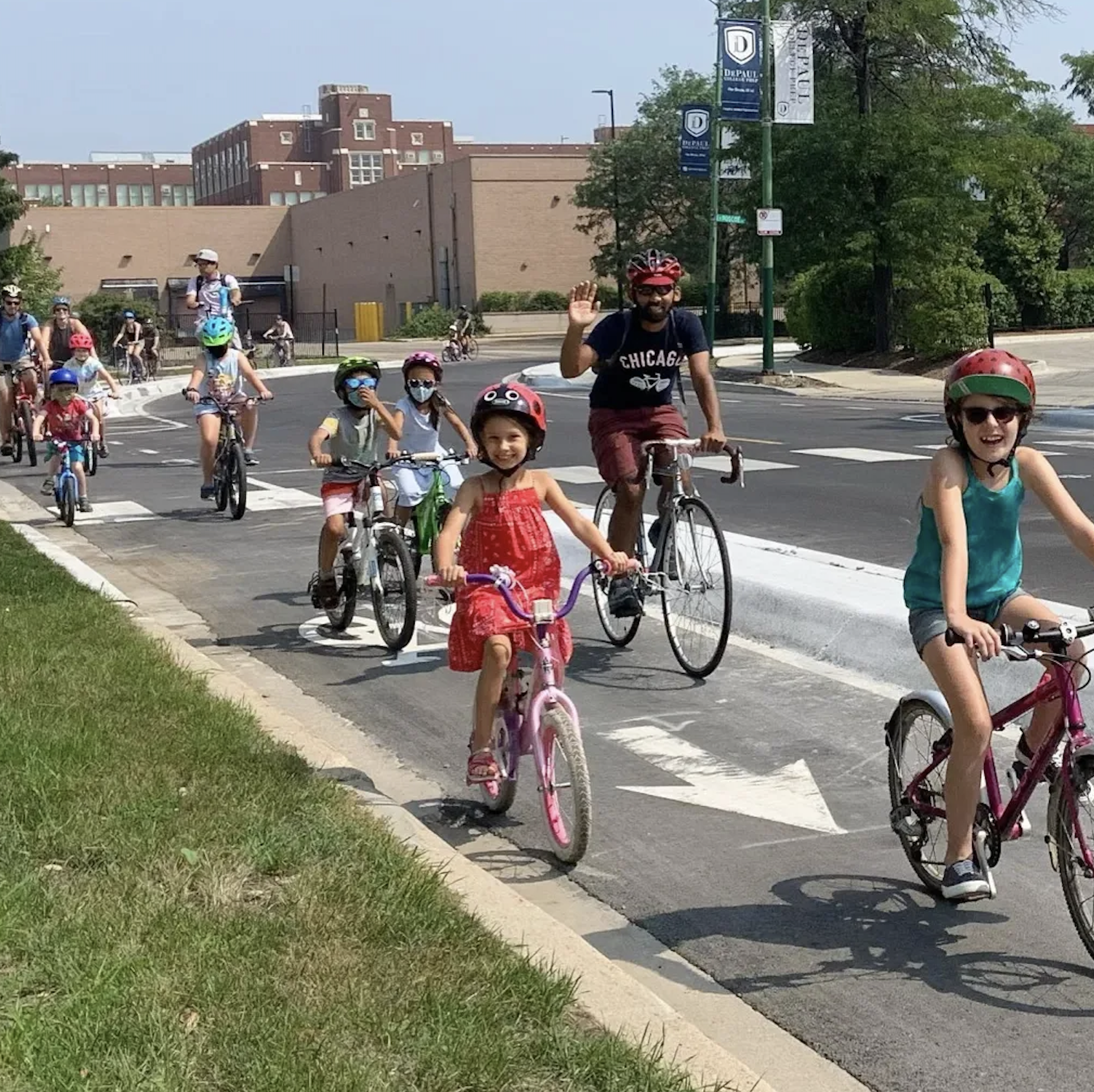The Chicago Department of Transportation is in the midst of a project to install 100 miles of new and upgraded bikeways in 2021-22. But cycling advocates have pointed out that our city still lacks a plan for a citywide network of connected, physically protected bike lanes. That's will actually make biking a safe and appealing transportation and recreation option for everyday residents, not just bike enthusiasts.
Meanwhile, New York City is making progress on creating more bikeways with sturdy concrete protection that will actually make "normal" people consider riding on city streets. Newly elected mayor Eric Adams promised that the local transportation department would bolster 50 percent of bike lanes that are classified as "protected" but that, like many Chicago protected bike lanes, are merely delineated with paint and flimsy plastic posts. Such treatments do relatively little to stop drivers from parking in them, let alone prevent reckless motorists from careening into them and striking bike riders.
Granted, the NYC project got off to a slow start. New transportation chief Ydanis Rodriguez initially promised that crews would reinforce 20 out of the city's 40 miles of "delineator-protected" bike lanes with concrete barriers within his first 100 days on the job. However, last month NYC DOT moved the goalpost, with an announcement that the 20 miles won't actually get concrete until as late as the end of 2023.
This #Biketober, NYC DOT will begin implementing midtown crosstown protected #BikeNYC lanes on 11th Ave (W 38th-W 42nd Sts) & W 40th St (11th-12th Aves). This work will:🌳Add greenway connections🚲Install protected bike lanes🚗Improve traffic flow🚶♂️Install pedestrian islands pic.twitter.com/p8hsjDtREZ
— NYC DOT (@NYC_DOT) October 1, 2021
Still, slow movement on a significant pledge to harden bike lane protection is better than little or no movement in that department, which is what's happening in Chicago. CDOT's plan for 100 miles of new or improved bike lanes in 2021-22 calls for only 12 miles of protected lanes, and it's not clear how many of those miles, if any will get sturdy, driver-resistant protection like concrete curbs, Jersey barriers, or car-proof bollards.
I would love to see CDOT chief Gia Biagi make a promise similar to this one from Commissioner Rodriguez – and follow through with it in a timely manner. “New York City’s cyclists deserve to be safe everywhere, but especially in protected lanes – where drivers will too often disrespect and block that critical space,” Rodriguez said. “We have an actionable, concrete plan to protect cyclists and we are going to deliver on this work to keep our lanes clear. We thank our friends in the advocacy community for helping us identify top targets – and we know that these 20 miles of barriers will make a real difference.”
FYI #BikeNYC: @NYC_DOT is installing Jersey barriers to protect the bike lane on Broadway in FiDi.
— tim-my 🚊🛫🏳️🌈 (@TimmyShea) February 18, 2022
It seems @NYCMayor is starting to make good on his promise! https://t.co/wXeaAKf3nC pic.twitter.com/j8PjL3lDfy
I reached out to Chicago sustainable transportation advocacy groups for their thoughts on this issue. “Protected bike lanes make streets safer for everyone while encouraging more people to ride," said Active Transportation Alliance spokesperson Kyle Whitehead. "It’s past time for Mayor [Lori] Lightfoot and Commissioner Biagi to commit to time-limited goals to upgrade existing protected bikeways to concrete and build new PBLs citywide. Plastic [posts] were never meant to be a permanent solution yet our static transportation bureaucracy and a lack of political leadership have made it so.”
Kyle Lucas, a cofounder of Better Streets Chicago (as am I), contrasted NYC’s efforts with our city's progress. “Chicago has really stalled when it comes to building bike infrastructure that will attract and maintain new riders," he said. "I can’t think of any biking infrastructure project in the past five years that we can point to and say was a success. While NYCs efforts may not be perfect, the fact that they are listening to cyclists and are responding is more than I can say CDOT is doing. I’d love to receive a CDOT newsletter with a plan to triple or quadruple our protected bike lane mileage and the creation of an advisory committee that has real power when it comes to steering CDOT’s work.” The Mayor's Bicycle Advisory Council meetings, hosted by CDOT, normally take place on a quarterly basis, but haven't happened since before the COVID-19 pandemic hit Chicago.
It bears repeating that CDOT classifies the Clark Street bike lanes in Edgewater, which has portions where the bike lanes are delineated with paint and plastic posts, to be a protected bike route, despite the fact that drivers constantly park in it. After advocacy by Better Streets, local alderman Andre Vasquez, and others, the department added more posts and has promised to install concrete protection this year. But as of last week the bike were still car-clogged, as you can see in this video.
another Sunday w/ Clark st bike lanes full of cars, no sign of enforcement @clarkstbikelane @bikelaneuprise #bikechi
— Dana (@teflonics) March 13, 2022
any chance you can talk to the futsal folks about this @Andrefor40th? it worked pretty well with dominos
maybe they can all just park in the car lanes too..... pic.twitter.com/yzhlNgqr4q
However, I don't think concrete barriers alone will be enough to prevent drivers from parking in bike lanes like the ones on Clark Street. There should also be measures to stop motorists from entering the bikeways, perhaps concrete or metal bollards, covered with reflective paint, at the entrances and entrance of each bike lane segment. Parking and driving in bike lanes is also much less of an issue when the bikeways are raised above street level.
Have you encountered any well-designed bike lanes that prevent motorists from entering them? Share a link in the comments.





